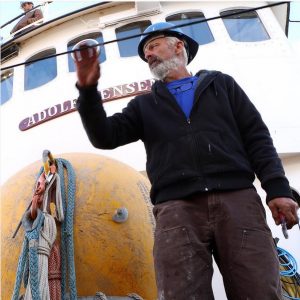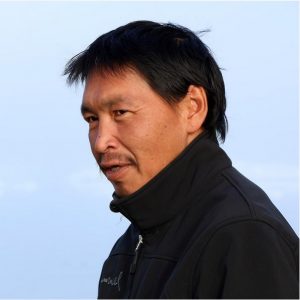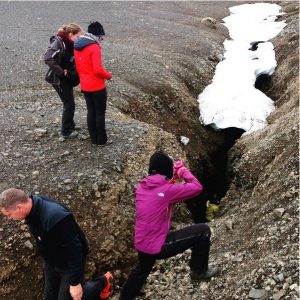The Art of Storytelling – Part 2: The Heart
When I was in Greenland and Iceland, I explored the heart dimension of the science through a series of Instagram essays that I wrote. Each essay paired a photo from my field reporting with a short block of written narrative. (This is an approach and medium I’d encourage you to consider using – it’s technically simple and takes a short amount of time. You can do it from the lab or the field.) Here are a few examples that get increasingly personal:
I’m convinced — the best tour guides in Iceland are the geophysicists. They take a landscape that looks like you’ve been abandoned on the moon (seriously — astronauts have trained here), and they translate it into the various grunts, stretches, and molten yearnings of the Earth below. There are sinkholes, fire fountains, frost cracks, even volcanoes that detonate beneath glaciers and trigger flash floods. “I feel like a kid in a toy shop,” says geophysicist Páll Einarsson, because even at age 68, his country is finding ways to surprise him. Once, Sveinbjörn Steinþôrsson stood 50 feet from a fracture that was just starting to open, belching fire. Geophysics is the VIP pass for the greatest show that is the Earth.
In this next example, I highlight what was happening onboard the research vessel through the perspective of one of the people involved with the science effort.
 “I woke up stiff.” Forty years on ships hauling 2000 pound instruments will do that to you. “I’ve broken the horns off a couple of my vertebrae,” Will Ostrom casually admits, moments before beginning another 12-hour day at sea. And yet this is where he’s most at home: aboard a trawler, a catamaran, an icebreaker – deploying and retrieving moorings, the scientific equipment that takes the vital signs of the ocean (how fresh or salty the water, how fast or slow the current). These moorings are massive – anchors that would flatten a car, enough cable to encircle a football field, and bright yellow flotation spheres the size of wrecking balls. Ostrom relies on winches and cranes to do the heavy lifting, but he’s constantly maneuvering the leviathans over the rail, shackling and unshackling fathoms of line — choreographing the elaborate dance of science on deck.
“I woke up stiff.” Forty years on ships hauling 2000 pound instruments will do that to you. “I’ve broken the horns off a couple of my vertebrae,” Will Ostrom casually admits, moments before beginning another 12-hour day at sea. And yet this is where he’s most at home: aboard a trawler, a catamaran, an icebreaker – deploying and retrieving moorings, the scientific equipment that takes the vital signs of the ocean (how fresh or salty the water, how fast or slow the current). These moorings are massive – anchors that would flatten a car, enough cable to encircle a football field, and bright yellow flotation spheres the size of wrecking balls. Ostrom relies on winches and cranes to do the heavy lifting, but he’s constantly maneuvering the leviathans over the rail, shackling and unshackling fathoms of line — choreographing the elaborate dance of science on deck.
There just aren’t a lot of new folks getting into the mooring business. So Ostrom gets pulled out of retirement to do the work he’s mastered over a lifetime. “This is my final trip,” he vows. A smile flashes across his face. That’s what he said the last time.
Finally, consider panning the focus of your story away from the science. I tried to talk to people who were doing work in service of the science, but who weren’t the scientists themselves. For instance:
 When he was a kid, Anders Maqe would go to sea with his grandparents in a little motorboat in the waters off southeastern Greenland. His grandfather was hunting for seal. After returning ashore, Anders would look on as his grandparents sliced up some of the meat to give away to the neighbors. That was the way – everyone benefited from a successful hunt. And it’s the reason that Anders was able to articulate, by age 10, that he wanted to become a cook. “I love [to] make food for other people.” It’s the giving of food to others that inspires him to do his best work.
When he was a kid, Anders Maqe would go to sea with his grandparents in a little motorboat in the waters off southeastern Greenland. His grandfather was hunting for seal. After returning ashore, Anders would look on as his grandparents sliced up some of the meat to give away to the neighbors. That was the way – everyone benefited from a successful hunt. And it’s the reason that Anders was able to articulate, by age 10, that he wanted to become a cook. “I love [to] make food for other people.” It’s the giving of food to others that inspires him to do his best work.
His first dish, which he made all by himself for his elementary school class, was pasta with meat sauce. Did they like it, I ask. Of course, he grins.
He’s been a professional cook for 13 years – in restaurants, on ships, at home. “Every day is a challenge. I think about how to make good food for people each day.” Do you ever cook seal, I ask. That’s a stupid question, he grins. Of course he does. He boils it with rice and onions. It’s the best way. Just like his grandparents showed him.


